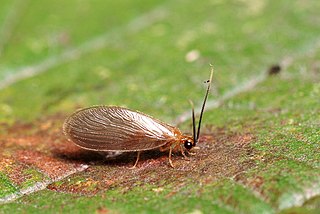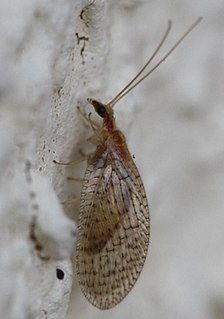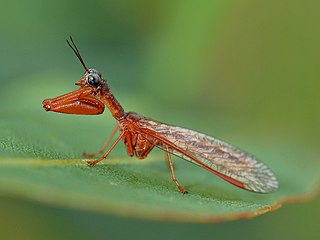
Green lacewings are insects in the large family Chrysopidae of the order Neuroptera. There are about 85 genera and 1,300–2,000 species in this widespread group. Members of the genera Chrysopa and Chrysoperla are very common in North America and Europe; they are very similar and many of their species have been moved from one genus to the other time and again, and in the nonscientific literature assignment to Chrysopa and Chrysoperla can rarely be relied upon. Since they are the most familiar neuropterans to many people, they are often simply called "lacewings". Since most of the diversity of Neuroptera are properly referred to as some sort of "lacewing", common lacewings is preferable.

Hemerobiidae is a family of Neuropteran insects commonly known as brown lacewings, comprising about 500 species in 28 genera. Most are yellow to dark brown, but some species are green. They are small; most have forewings 4–10 mm long. These insects differ from the somewhat similar Chrysopidae not only by the usual coloring but also by the wing venation: hemerobiids differ from chrysopids in having numerous long veins and forked costal cross veins. Some genera are widespread, but most are restricted to a single biogeographical realm. Some species have reduced wings to the degree that they are flightless. Imagines (adults) of subfamily Drepanepteryginae mimic dead leaves. Hemerobiid larvae are usually less hairy than chrysopid larvae.

Sisyridae, commonly known as spongeflies or spongillaflies, are a family of winged insects in the order Neuroptera. There are approximately 60 living species described, and several extinct species identified from the fossil record.

Sympherobius is a genus of brown lacewings in the family Hemerobiidae. There are at least 50 described species in Sympherobius.
Glenurus luniger is a species of antlion in the family Myrmeleontidae. It is found in Central America and North America.
Lomamyia longicollis is a species of beaded lacewing in the family Berothidae. It is found in North America.
Eremochrysa pallida is a species of green lacewing in the family Chrysopidae. It is found in North America.
Eremochrysa is a genus of shadow lacewings in the family Chrysopidae. There are about 18 described species in Eremochrysa.

Micromus tasmaniae, known as the Tasmanian brown lacewing, is a species of brown lacewing in the family Hemerobiidae. It is widespread in Australia, New Zealand, and Pacific Islands such as New Caledonia and Vanuatu.

Glenurus is a genus of antlions in the family Myrmeleontidae. There are about 12 described species in Glenurus.

Lomamyia is a genus of beaded lacewings in the family Berothidae. There are about 11 described species in Lomamyia.

Negha is a genus of square-headed snakeflies in the family Inocelliidae. There are at least three described species in Negha.

Hemerobius humulinus is a species of brown lacewing in the family Hemerobiidae. It is found in Europe and Northern Asia, North America, and Southern Asia.

Mantispinae is a subfamily of mantidflies in the family Mantispidae. There are at least 30 genera and 310 described species in Mantispinae.

Leucochrysini is a tribe of green lacewings in the family Chrysopidae. There are 7 genera and 213 described species in Leucochrysini.

Psectra is a genus of brown lacewings in the family Hemerobiidae. There are more than 20 described species in Psectra.

Nusalala is a genus of brown lacewings. The scientific name was published in 1913 by Longinos Navás. They belong to the subfamily Microminae, as well as the genera Micromus and Megalomina.
Some species of this genus, such as Nusalala brachyptera, are "brachypter" meaning short wings, and have lost the ability to fly; they can only jump. This phenomenon has evolved in a number of genera in the family Hemerobiidae
Megalomus carpenteri is a species of brown lacewing in the family Hemerobiidae. It is found in North America. The specific epithet carpenteri honors paleoentomologist Frank M. Carpenter for his taxonomic work on the Neuroptera.
Yumachrysa is a genus of green lacewings in the family Chrysopidae. There are at least four described species in Yumachrysa.

Drepanacra binocula, known as the Australian variable lacewing, is a species of brown lacewing in the family Hemerobiidae, found across Australia and New Zealand, including Lord Howe Island, Norfolk Island and the Kermadec Islands.















